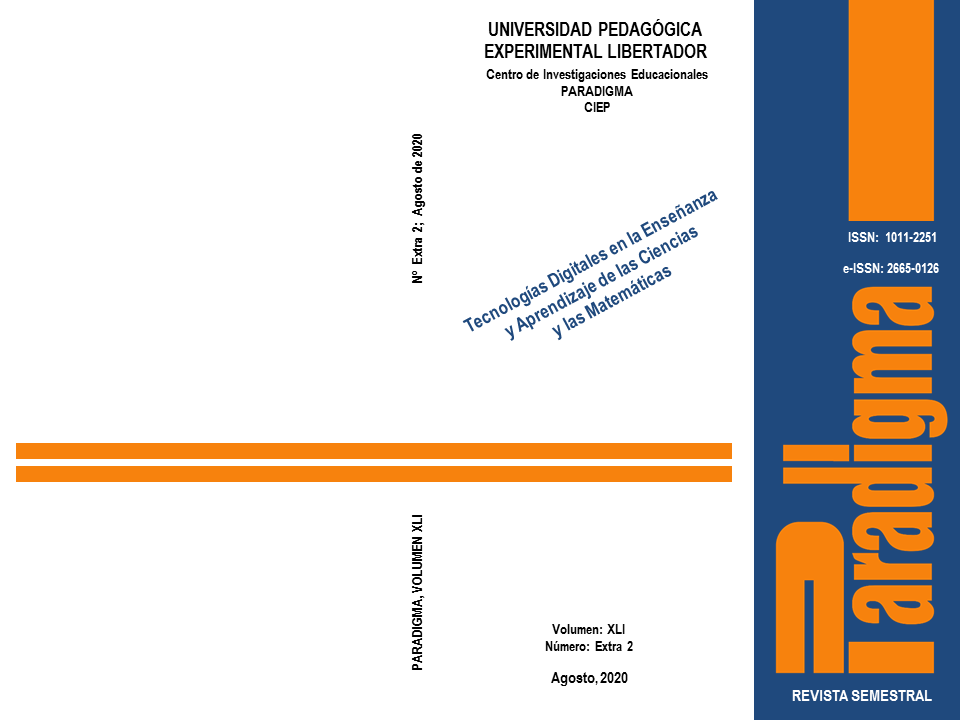Funciones vectoriales y curvas en el espacio mediante software de geometría dinámica: Una experiencia sobre la génesis instrumental de profesores en formación
DOI:
10.37618/PARADIGMA.1011-2251.0.p328-352.id910Keywords:
Curvas, funciones vectoriales, GeoGebra, Génesis instrumental personalAbstract
En este reporte se presenta la actividad matemática en que se enrolan profesores en formación en torno al trabajo con funciones vectoriales, particularmente respecto a la visualización de curvas en el espacio mediante GeoGebra. Con base en los elementos teóricos de la aproximación instrumental del uso de herramientas tecnológicas, en su enfoque ergonómico, los resultados de nuestro estudio revelan cómo los profesores utilizan herramientas particulares del software de Geometría Dinámica GeoGebra como instrumento que les permite la reflexión matemática sobre curvas y vectores en el espacio. El estudio se enfoca en el análisis de la génesis instrumental a nivel personal respecto al uso del arrastre a través de deslizadores. Las formas de uso de la herramienta tecnológica por parte de los futuros profesores para visualizar la curva que genera la función vectorial se pueden clasificar en tres: el uso de deslizadores para generar una familia de vectores y el rastro visualizar la curva generada; el uso del registro numérico mediante la hoja de cálculo y la conversión hacia la representación gráfica; el uso del deslizador y el rastro para visualizar tanto la curva generada como los vectores que la producen.Downloads
References
Bozkurt, G., Uygan, C. y Turgut, M. (2018). Instrumental genesis of a preservice mathematics teacher: instrumented actions for perpendicular line construction in a dynamic geometry environment. En H.G. Weigand, A. Clarck-Wilson, et al. (Eds.), Proceedings of the 5th ERME Topic Conference MEDA. Copenague, Dinamarca: Universidad de Copenague. Disponible en http://www.math.ku.dk/english/research/conferences/2018/meda
Cory, B. L. y Garofolo, J. (2011). Using Dynamic Sketches to enhance preservice secondary mathematics teachers’ understanding of limits of sequences. Journal for Research in Mathematics Education, 42(1), 65-97. Disponible en https://www.researchgate.net/publication/259749831_Using_Dynamic_Sketches_to_Enhance_Preservice_Secondary_Mathematics_Teachers'_Understanding_of_Limits_of_Sequences. Acceso 23 de marzo de 2020.
Drijvers, P. y Trouche, L. (2008). From artifacts to instruments, a theoretical framework behind the orchestra metaphor. En G. W. Blume & M. K. Heid (Eds.), Research on technology and the teaching and learning of mathematics: Vol. 2 cases, and perspectives (pp. 363-391). Charlotte, NC: Information Age Publishing.
Gómez-Chacón, I. M., Botana, F., Escribano, J. y Abánades, M. A. (2016). The concept of Locus. Genesis of personal and professional use with different tools. Bolema, 30(54), 67-94.
Haspekian, M. (2011). The co-construction of a mathematical and a didactical instrument. En M. Pytlak, T. Rowland, & E. Swoboda (Eds.) Proceedings of of the 7th Congress of the European Society for Research in Mathematics Education (CERME7) (pp. 2298- 2307). Rzeszów: University of Rzeszów.
Hegedus, S., Laborde, C. Brady, C. Dalton, S. et. al. (2017). Uses of technology in upper secondary mathematics education. ICME-13 Topical Surveys. Suiza: Springer.
Holm, J. (2019). Supporting the development of future mathematics teachers: mathematics as healing. En S. Otten, A. G. Candela, Z. de Araujo, C. Haines, & C.
Munter (2019). Proceedings of the forty-first annual meeting of the North American Chapter of the International Group for the Psychology of Mathematics Education (pp. 1203-1207). St Louis, MO: University of Missouri.
Huang, R. y Zbiek, R. M. (2017). Prospective Secondary Mathematics Teacher Education Preparation and Technology. En M. E. Strutchens, R. Huang, L. Losano, Potari D. et al. (Eds.), The Mathematics Education of Prospective Seconadry Teachers Around the World. ICME-13 Topical Surveys (pp. 17-24). Suiza: Springer.
Lobo da Costa, N. M., Galvao, M. E. y Prado, M.E. (2017). Integration of Digital Technologies in Mathematics Teacher Education: The Reconstruction Process of Previous Trigonometrical Knowledge. En G. Aldon, F. Hitt, L. Bazzini & U. Gellert (Eds.), Mathematics and Technology (pp. 523-550). Suiza: Springer.
Martínez-Hernández, C. y Ulloa-Azpeitia, R. (2017). Dynamic Geometry Software and tracing tangents in the context of the mean value theorem: technique and theory production. International Journal for Technology in Mathematics Education, 24(2), 75-82.
Mishra, P., y Koehler, M. J. (2006). Technological pedagogical content knowledge: A framework for integrating technology in teacher knowledge. Teachers College Record, 108(6), 1017–1054.
Rabardel, P. (2002). People and technology-a cognitive approach to contemporary instruments. Université Paris 8. Disponible en https://hal-univ- paris8.archives-ouvertes.fr/file/index/docid/1020705/filename/people_and_technology.pdf. Acceso 10 de marzo de 2020.
Rocha, H. (2020). Graphical representations of functions using technology: a window to teacher knowledge. Teaching Mathematics and Its Aplictions. 39(2), 105-126.
Santos, J.A. y Acuña, C.M. (2015). La tablet electronica, la genesis instrumental y los profesores de bachillerato. En R. Flores (Ed.), Acta Latinoamericana de Matemática Educativa Vol. (28). México: Comité Latinoamericano de Matemática Educativa AC.
Stewart, J. (2012). Cálculo de varias variables. Trascendentes tempranas. México: Cengage Learning.
Tabach, M. y Trgalová, J. (2018). ICT standards for teachers: Toward a frame defining mathematics teachers’ digital knowledge. En H-G. Weigand, et al. (Eds.), Proceedings of the 5th ERME Topic Conference. Mathematics Education in the Digital Age (pp. 273-280). Dinamarca: Universidad de Copenhagen.
Trouche, L. (2005). Instrumental genesis, individual and social aspects. In D. Guin, K. Ruthven, & L. Trouche (Eds.), The didactical challenge of symbolic calculators: Turning a computational device into a mathematical instrument (pp. 197–230). New York: Springer.
Trouche, L. & Drijvers, P. (2010). Handheld technology for mathematics education: flashback into the future. ZDM, 42, 667-681.
Vasilachis, I. (2006). Estrategias de investigación cualitativa. Barcelona: Gedisa.
Downloads
Additional Files
Published
Métricas
Visualizações do artigo: 494 PDF (Español (España)) downloads: 233 Sin título (Español (España)) downloads: 0


 English
English
 Español (España)
Español (España)
 Français (France)
Français (France)
 Português (Brasil)
Português (Brasil)




















































